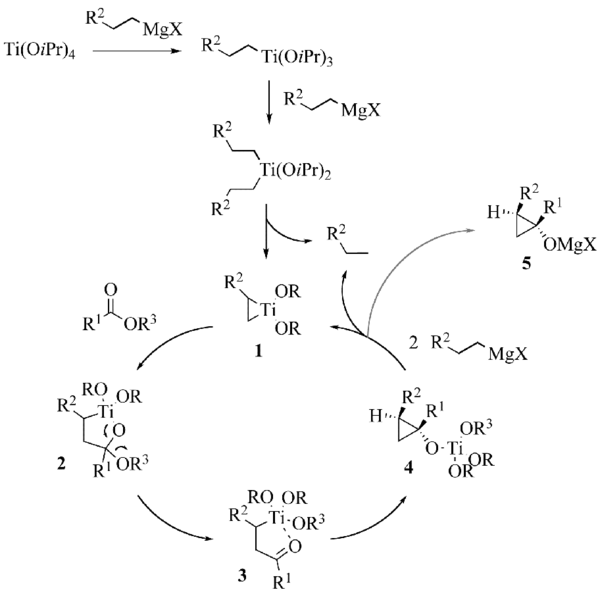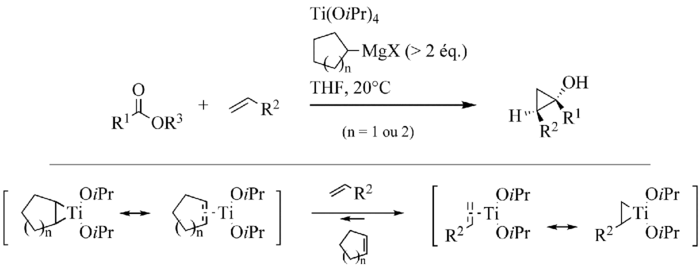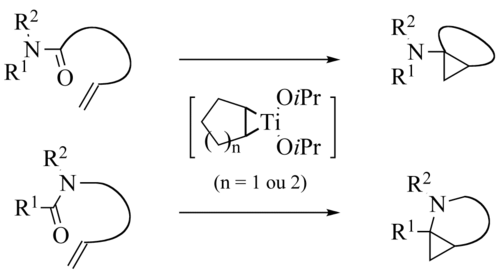Chemistry:Kulinkovich reaction
| Kulinkovich reaction | |
|---|---|
| Named after | Oleg Kulinkovich |
| Reaction type | Ring forming reaction |
| Identifiers | |
| Organic Chemistry Portal | kulinkovich-reaction |
| RSC ontology ID | RXNO:0000682 |
The Kulinkovich reaction describes the organic synthesis of substituted cyclopropanols through reaction of esters with dialkyldialkoxytitanium reagents, which are generated in situ from Grignard reagents containing a hydrogen in beta-position and titanium(IV) alkoxides such as titanium isopropoxide.Cite error: Closing </ref> missing for <ref> tag
In broad strokes, and in a formal retrosynthetic sense, titanacyclopropane 1 behaves like a 1,2-dianion which adds into the ester twice: after the first addition into the ester, the resultant tetrahedral intermediate 2 collapses to give β-titanio ketone 3, which undergoes a second intramolecular addition to give the titanium salt of the cyclopropanol (4). (This species then undergoes transmetalation with Grignard reagent to regenerate 1 and close the catalytic cycle and give the product in the form of the magnesium salt (5).)
The reaction mechanism has been the subject of theoretical analysis.[1] Certain points remain nevertheless obscure. Intermediate titanium complexes of the ate type have been proposed by Kulinkovich.[2]
Ligand exchange with olefins
In 1993, the team of Kulinkovich highlighted the aptitude of the titanacyclopropanes to undergo ligand exchange with olefins.[3] This discovery was important, because it gave access to cyclopropanols more functionalized by making economic use of the Grignard of which normally at least two equivalents should have been engaged to obtain good yields. Cha and its team introduced the use of cyclic Grignard reagents, particularly adapted for these reactions.[4]
The methodology has been extended to intramolecular reactions[5]
De Meijere variation
| Kulinkovich–De Meijere reaction | |
|---|---|
| Named after | Oleg Kulinkovich Armin de Meijere |
| Reaction type | Ring forming reaction |
| Identifiers | |
| Organic Chemistry Portal | kulinkovich-demeijere-reaction |
| RSC ontology ID | RXNO:0000683 |
With amides instead of esters the reaction product is an aminocyclopropane in the De Meijere variation[6][7]
The intramolecular reaction is also known:[8][9][10][11][12][13][14][15][16][17]
Szymoniak variation
| Kulinkovich–Szymoniak reaction | |
|---|---|
| Named after | Oleg Kulinkovich Jan Szymoniak |
| Reaction type | Ring forming reaction |
| Identifiers | |
| Organic Chemistry Portal | kulinkovich-szymoniak-reaction |
| RSC ontology ID | RXNO:0000684 |
In the Szymoniak variation the substrate is a nitrile and the reaction product a cyclopropane with a primary amine group.[18][19]
The reaction mechanism is akin the Kulinkovich reaction:
Additional reading
- Kulinkovich, O. G.; Sviridov, S. V.; Vasilevski, D. A. (1991). "Titanium(IV) Isopropoxide-Catalyzed Formation of 1-Substituted Cyclopropanols in the Reaction of Ethylmagnesium Bromide with Methyl Alkanecarboxylates". Synthesis 1991 (3): 234. doi:10.1055/s-1991-26431.
- Kulinkovich, O. G.; De Meijere, A. (2000). "1,n-Dicarbanionic Titanium Intermediates from Monocarbanionic Organometallics and Their Application in Organic Synthesis". Chem. Rev. 100 (8): 2789–834. doi:10.1021/cr980046z. PMID 11749306.
- Sato, F.; Urabe, H.; Okamoto, S. (2000). "Synthesis of organotitanium complexes from alkenes and alkynes and their synthetic applications". Chem. Rev. 100 (8): 2835–86. doi:10.1021/cr990277l. PMID 11749307.
- Wu, Y.-D.; Yu, Z.-X. (2001). "A theoretical study on the mechanism and diastereoselectivity of the Kulinkovich hydroxycyclopropanation reaction". J. Am. Chem. Soc. 123 (24): 5777–86. doi:10.1021/ja010114q. PMID 11403612.
- Kulinkovich, O. G. (2004). "Alkylation of carboxylic acid derivatives with dialkoxytitanacyclopropane reagents". Russ. Chem. Bull. 53 (5): 1065–1086. doi:10.1023/B:RUCB.0000041303.52400.ca.
- Wolan, A.; Six, Y. (2010). "Synthetic transformations mediated by the combination of titanium(IV) alkoxides and grignard reagents: Selectivity issues and recent applications. Part 1: Reactions of carbonyl derivatives and nitriles". Tetrahedron 66: 15–61. doi:10.1016/j.tet.2009.10.050.
- Wolan, A.; Six, Y. (2010). "Synthetic transformations mediated by the combination of titanium(IV) alkoxides and Grignard reagents: Selectivity issues and recent applications. Part 2: Reactions of alkenes, allenes and alkynes". Tetrahedron 66 (17): 3097–3133. doi:10.1016/j.tet.2010.01.079.
- Corey, E. J.; Rao, S. A.; Noe, M. C. (1994). "Catalytic Diastereoselective Synthesis of Cis-1,2-Disubstituted Cyclopropanols from Esters Using a Vicinal Dicarbanion Equivalent". Journal of the American Chemical Society 116 (20): 9345. doi:10.1021/ja00099a068.
References
- ↑ Wu, Y.–D. and Yu, Z.-X. (2001). "A theoretical study on the mechanism and diastereoselectivity of the Kulinkovich hydroxycyclopropanation reaction". J. Am. Chem. Soc. 123 (24): 5777–86. doi:10.1021/ja010114q. PMID 11403612.
- ↑ Kulinkovich, O. G.; Kananovich, D. G. (2007). "Advanced Procedure for the Preparation ofcis-1,2-Dialkylcyclopropanols – Modified Ate Complex Mechanism for Titanium-Mediated Cyclopropanation of Carboxylic Esters with Grignard Reagents". Eur. J. Org. Chem. 2007 (13): 2121–32. doi:10.1002/ejoc.200601035.
- ↑ Kulinkovich, O. G.; Savchenko, A. I.; Sviridov, S. V.; Vasilevski, D. A. (1993). "Titanium(IV) Isopropoxide-catalysed Reaction of Ethylmagnesium Bromide with Ethyl Acetate in the Presence of Styrene". Mendeleev Commun. 3 (6): 230–31. doi:10.1070/MC1993v003n06ABEH000304.
- ↑ Lee, J.; Kim, H.; Cha, J. K. (1996). "A New Variant of the Kulinkovich Hydroxycyclopropanation. Reductive Coupling of Carboxylic Esters with Terminal Olefins". J. Am. Chem. Soc. 118 (17): 4198–99. doi:10.1021/ja954147f.
- ↑ Kasatkin, A.; Sato, F. (1995). "Diastereoselective synthesis of trans-1,2-disubstituted cyclopropanols from homoallyl or bis-homoallyl esters via tandem intramolecular nucleophilic acyl substitution and intramolecular carbonyl addition reactions mediated by Ti(OPr-i)4 / 2 i-PrMgBr reagent". Tetrahedron Lett. 36 (34): 6079–82. doi:10.1016/0040-4039(95)01208-Y.
- ↑ Chaplinski, V.; De Meijere, A. (1996). "A Versatile New Preparation of Cyclopropylamines from Acid Dialkylamides". Angew. Chem. Int. Ed. 35 (4): 413–14. doi:10.1002/anie.199604131.
- ↑ De Meijere, A.; Winsel, H. and Stecker, B. Organic Syntheses, Vol. 81, p. 14
- ↑ Lee, J.; Cha, J. K. (1997). "Facile Preparation of Cyclopropylamines from Carboxamides". The Journal of Organic Chemistry 62 (6): 1584. doi:10.1021/jo962368d.
- ↑ Chaplinski, V.; Winsel, H.; Kordes, M.; De Meijere, A. (1997). "A New Versatile Reagent for the Synthesis of Cyclopropylamines Including 4-Azaspiro[2.n]alkanes and Bicyclo[n.1.0]alkylamines". Synlett 1997: 111–114. doi:10.1055/s-1997-17828.
- ↑ Cao, B.; Xiao, D.; Joullié, M. M. (1999). "Synthesis of Bicyclic Cyclopropylamines by Intramolecular Cyclopropanation of N-Allylamino Acid Dimethylamides". Organic Letters 1 (11): 1799. doi:10.1021/ol9910520. PMID 10814442.
- ↑ Lee, H. B.; Sung, M. J.; Blackstock, S. C.; Cha, J. K. (2001). "Radical cation-mediated annulation. Stereoselective construction of bicyclo[5.3.0]decan-3-ones by aerobic oxidation of cyclopropylamines". Journal of the American Chemical Society 123 (45): 11322–11324. doi:10.1021/ja017043f. PMID 11697988.
- ↑ Gensini, M.; Kozhushkov, S. I.; Yufit, D. S.; Howard, J. A. K.; Es-Sayed, M.; Meijere, A. D. (2002). "3-Azabicyclo[3.1.0]hex-1-ylamines by Ti-Mediated Intramolecular Reductive Cyclopropanation of α-(N-Allylamino)-Substituted N,N-Dialkylcarboxamides and Carbonitriles". European Journal of Organic Chemistry 2002 (15): 2499. doi:10.1002/1099-0690(200208)2002:15<2499::AID-EJOC2499>3.0.CO;2-V.
- ↑ Tebben, G. D.; Rauch, K.; Stratmann, C.; Williams, C. M.; De Meijere, A. (2003). "Intramolecular Titanium-Mediated Aminocyclopropanation of Terminal Alkenes: Easy Access to Various Substituted Azabicyclo[n.1.0]alkanes1". Organic Letters 5 (4): 483–485. doi:10.1021/ol027352q. PMID 12583749.
- ↑ Ouhamou, N.; Six, Y. (2003). "Studies on the intramolecular Kulinkovich?De Meijere reaction of disubstituted alkenes bearing carboxylic amide groups". Organic & Biomolecular Chemistry 1 (17): 3007–9. doi:10.1039/b306719j. PMID 14518121.
- ↑ Gensini, M.; De Meijere, A. (2004). "Cyclopropane-Annelated Azaoligoheterocycles by Ti-Mediated Intramolecular Reductive Cyclopropanation of Cyclic Amino Acid Amides". Chemistry: A European Journal 10 (3): 785–790. doi:10.1002/chem.200305068. PMID 14767944.
- ↑ Larquetoux, L.; Kowalska, J. A.; Six, Y. (2004). "The Formal [3+2+1] Cyclisation of Cyclopropylamines with Carboxylic Anhydrides: A Quick Access to Polysubstituted 2,3,3a,4-Tetrahydro6(5H)-indolone Ring Systems". European Journal of Organic Chemistry 2004 (16): 3517. doi:10.1002/ejoc.200400291.
- ↑ Larquetoux, L.; Ouhamou, N.; Chiaroni, A. L.; Six, Y. (2005). "The Intramolecular Aromatic Electrophilic Substitution of Aminocyclopropanes Prepared by the Kulinkovich–De Meijere Reaction". European Journal of Organic Chemistry 2005 (21): 4654. doi:10.1002/ejoc.200500428.
- ↑ Bertus, P.; Szymoniak, J. (2001). "New and easy route to primary cyclopropylamines from nitriles". Chemical Communications (18): 1792–1793. doi:10.1039/b105293b. PMID 12240317.
- ↑ Chaplinski, V.; De Meijere, A. (1996). "A Versatile New Preparation of Cyclopropylamines from Acid Dialkylamides". Angewandte Chemie International Edition in English 35 (4): 413. doi:10.1002/anie.199604131.
 |







